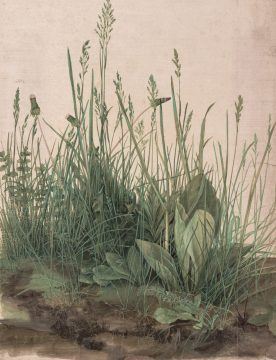by Brooks Riley
 When Vienna‘s Albertina Museum exhibition of works by Albrecht Dürer ended in January 2020, it seemed quite possible that several of the masterpieces on display might never again be seen by the public, among them The Great Piece of Turf. This may sound like a dire prediction for a fragile work that is routinely exhibited every decade or so, but as the UN announced recently, we may already have passed the tipping point in the race to save our world and ourselves. A decade from now we may be too engaged in the struggle to survive to focus our attention on a small, exquisite watercolor created 500 years ago.
When Vienna‘s Albertina Museum exhibition of works by Albrecht Dürer ended in January 2020, it seemed quite possible that several of the masterpieces on display might never again be seen by the public, among them The Great Piece of Turf. This may sound like a dire prediction for a fragile work that is routinely exhibited every decade or so, but as the UN announced recently, we may already have passed the tipping point in the race to save our world and ourselves. A decade from now we may be too engaged in the struggle to survive to focus our attention on a small, exquisite watercolor created 500 years ago.
Up to now, Dürer has been one of the many diversions that have lured me away from thinking about the climate crisis. At this moment in history, when focusing on the future of the planet is required, we are deluged by distractions than didn’t exist 30 years ago when the climate warnings began to escalate. We cram our free time with clickbait high and low, binges of movies and TV shows on streaming platforms, all-you-can-hear on Spotify, endless slide shows, political sideshows, not to mention all the other interests we may have that are accessible via Google or Wikipedia. Online shopping diverts us further, feeding desires ahead of needs. The outcry of scientists and the activism of Time magazine Person of the Year Greta Thunberg have done little to pry us from our pleasures.
The climate crisis will not wait for us to put down our devices and devote serious thought or action to the issue. As a species, we react more to major events than to chronic conditions. The climate crisis is not an event, it’s a slow-rolling inevitability that will play out in differing catastrophic scenarios, to be labeled events only when they occur. Meanwhile, this gathering storm hums along in the background of our lives as we go about business as usual—not unlike death, another inevitability whose faint background noise accompanies us throughout our lives.
How can we be excited at the likelihood of a cure for cancer in 20 years, or an eventual triumph over viruses, or the reversal of aging, when those advances may not matter anymore if our planet home has become unlivable? How can we watch our children grow and not worry whether they will have the same full, long life that we can expect?
Attention Deficit Disorder on a global, collective scale is not the only problem. Most of us are helpless to do anything significant to change the course of the environmental crisis. Without the expertise or the necessary degrees in science we can only hope that someone else out there will find a dramatic new solution to the CO2 problem or find a way to harness or transform those gases for some beneficial use. Or that someone else out there will develop a viable alternative economic model to replace this toxic version of globalization.
Maybe Dürer was on to something. A painter of emperors and billionaires, he nevertheless turned his attention and his talent to the humblest of sitters, a clump of earth with no fewer than nine different kinds of grasses and other plants growing from it. Everything about this watercolor, gouache and ink rendering is remarkable: its meticulous execution, the astonishing array of greens, the tangled roots peeking out beneath the surface, its homely essence captured in a notoriously difficult artistic technique. For Dürer, the time and effort spent on this lowly subject reflect his great appreciation of life at its most insignificant. (A passionate lover of nature, he would have thrilled at the billions of microscopic creatures that photomicrography would make visible today inside that chunk of earth.)
Dürer’s Great Piece of Turf is the poster child we need now, reminding us that we all stand on a piece of turf, even if it’s covered in asphalt. If planetary death is too cumbersome and complex for us to contemplate, we should go local and start with where we stand, that precious surface of the earth that we adhere to through gravity. What can I do on this very spot to help the planet? How much time can I redirect to this endeavor?
Where we stand on the climate crisis matters. Activism begins in the mind. A grassroots (no pun intended) movement that prioritizes saving the environment over every other issue should be our gift to the children who come after us, the ones who will otherwise suffer from our indifference. We are the grasses growing on Earth, our own Great Piece of Turf. We owe ourselves as much attention and devotion as Albrecht Dürer applied to his subject 500 years ago. In the great scheme of things, we may be just as small and insignificant as that handful of green, but we and our fellow creatures deserve to live, to survive, and to thrive. Dürer had to race against time to immortalize those plants before they wilted. We do, too.
